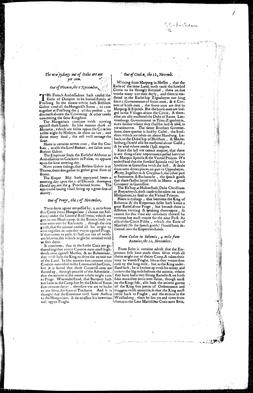The coranto is an early form of newspaper, published in England from the 1620s until the 1630s. Owing to restrictions placed on the publication of domestic news, they contained almost exclusively foreign news,[1] usually printed on a single broadside sheet of closely set text.[2] The term coranto is derived from the French courant, meaning running, reflecting the fact that these were periodical publications rather than one-off broadsheets.[3]
Corantos were first published in England by a syndicate including Nathaniel ButterEarly publisher of news in England, 1583–1664., Nicholas Bourne, Thomas Archer, Bartholomew Downes, and William Sheffard. In 1624 Butter and Bourne took over exclusively, and the adventurer turned writer Thomas Gainsford became their first editor.[1] But during the 1630s the political elite grew increasingly hostile towards popular expression,[4] and in October 1632 King Charles I banned the publication of corantos.[1]

